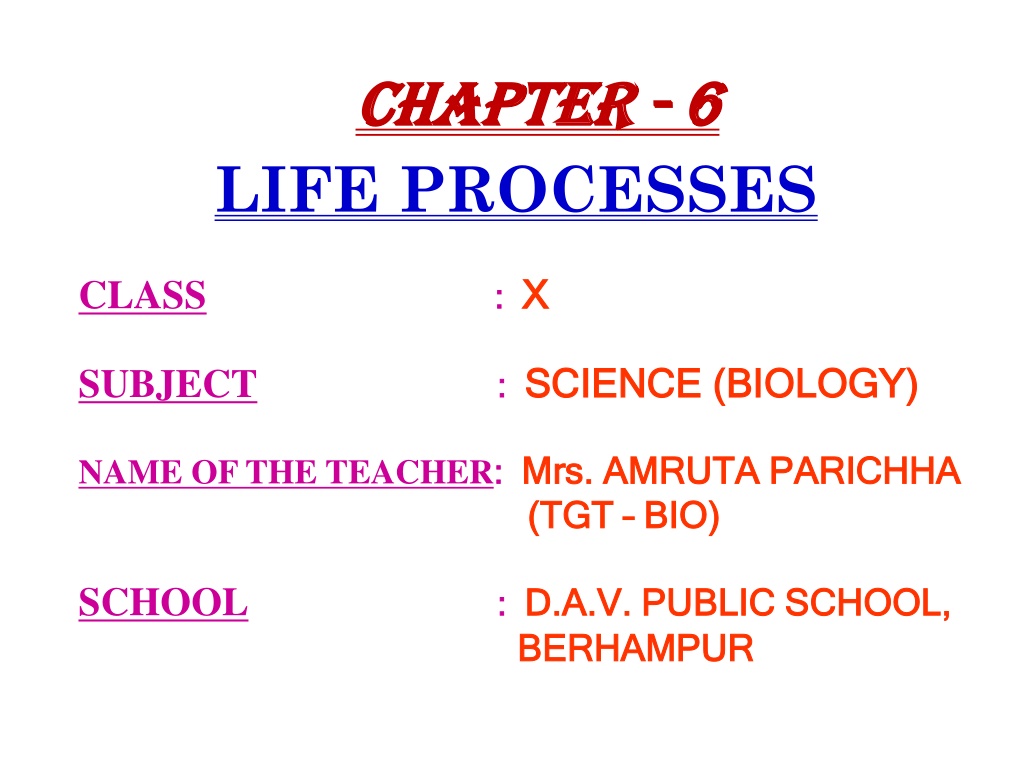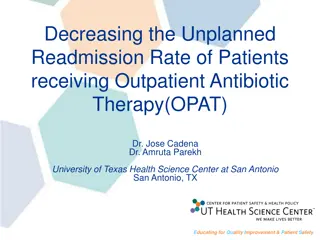Exploring Life Processes in Science Class X with Mrs. Amruta Parichha
In this chapter on life processes, students delve into the essential functions that sustain living organisms, including diffusion, reproduction, autotrophic and heterotrophic modes of nutrition, and photosynthesis. Mrs. Amruta Parichha, the dedicated teacher at D.A.V. Public School, Berhampur, guides students through understanding the importance of these processes for sustaining life and the differences between them.
Download Presentation

Please find below an Image/Link to download the presentation.
The content on the website is provided AS IS for your information and personal use only. It may not be sold, licensed, or shared on other websites without obtaining consent from the author. Download presentation by click this link. If you encounter any issues during the download, it is possible that the publisher has removed the file from their server.
E N D
Presentation Transcript
CHAPTER CHAPTER - - 6 6 LIFE PROCESSES CLASS : : X X SUBJECT : : SCIENCE (BIOLOGY) SCIENCE (BIOLOGY) NAME OF THE TEACHER: : Mrs. AMRUTA PARICHHA Mrs. AMRUTA PARICHHA (TGT SCHOOL : : D.A.V. PUBLIC SCHOOL, BERHAMPUR BERHAMPUR (TGT BIO) D.A.V. PUBLIC SCHOOL, BIO)
EXTRA QUESTIONS What are life processes? Why is diffusion insufficient to meet the multicellular organisms' oxygen requirements? Name the processes essential for maintaining life? What is the importance of reproduction to an organism when it is not essential for its survival?
EXTRA QUESTIONS What is difference between autotrophic and heterotrophic mode of nutrition? What are the necessary conditions for autotrophic nutrition and what are its by-products? Which cells are responsible for photosynthesis? What are the functions of stomata?
EXTRA QUESTIONS What are the steps involved in nutrition in amoeba or Phagocytosis? What are the various parts of an alimentary canal? What are the various digestive glands involved in the process of digestion in human? Where does digestion starts? What is the function of saliva? What is the function of epiglottis?
EXTRA QUESTIONS What are the functions of gastric glands present in the walls of the stomach? What are the functions of HCl in the stomach? Name the enzyme present in the gastric juice and what is its function? What is peristalsis? What happens to the food in the small intestine? What are the functions of villi?
EXTRA QUESTIONS The small intestine is the longest organ of the alimentary canal, then why is it denoted as small? What is the secretion of liver that helps in the process of digestion? What do mean by emulsification of fats? What are the functions of the enzymes amylase, trypsin and lipase? What is the cause of peptic ulcer and how it can be avoided?
EXTRA QUESTIONS Differentiate between aerobic and anaerobic respiration. How are the lungs designed in human beings to maximize the area of exchange of gases? Why there is always a residual volume of air present in the lungs? When is lactic acid formed in our muscles? How do aquatic animals like fish respire? Give the pathway of air in the human respiratory system.
EXTRA QUESTIONS Differentiate between arteries and veins. Explain why transportation of materials is necessary in animals. What causes anaemia? What are the functions of blood? Differentiate between blood and lymph. Why valves are present in veins? What is double circulation? Why the heart of birds and mammals are four-chambered?
EXTRA QUESTIONS What do you mean by translocation in plants? What are the functions of phloem tissues? How does transportation of water takes place in plants? Differentiate between xylem and phloem tissues. What is transpiration pull? What is root pressure?
EXTRA QUESTIONS What is the main function of kidneys in human? What is the composition of initial filtrate? What do you mean by ultra-filtration? What is the composition of urine? What are the useful substances reabsorbed during urine formation? What are the excretory substances needs to be removed from the blood? How does the plants remove the excretory substances?























